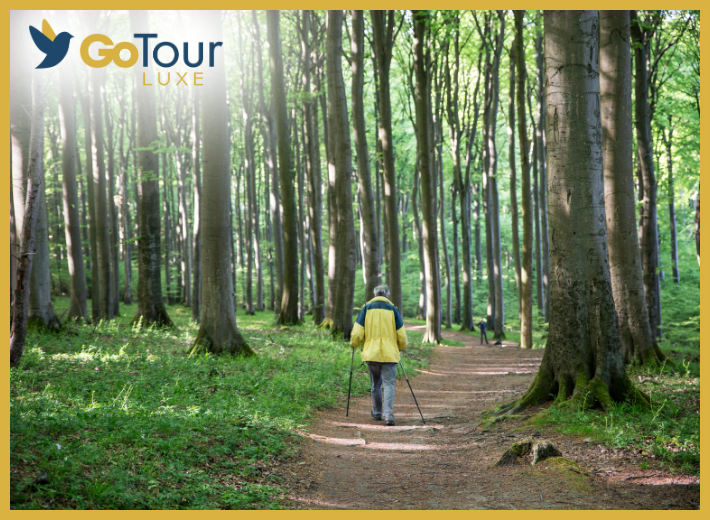National Forests to Explore this Summer

Summer is almost here! People are starting to plan their vacations and getaways. If you’re looking for a destination that’s less crowded than the typical national parks, consider exploring one of America’s incredible national forests. Immerse yourself in nature, explore hiking trails, camp under the stars, and much more.
Despite the immense vastness of most national parks, many can feel almost claustrophobic at times due to swarming crowds. At least three of the busiest parks—Arches, Glacier, and Rocky Mountain—require a timed-entry reservation to enter for much of the day during the high season, while snagging a campsite on recreation.gov during the prime summer months in many parks feels nigh impossible.
But for those willing to venture off the beaten path, national forests— often abutting and sometimes surrounding their national park cousins—offer similar scenery, with a fraction of the visitors.
Some forests may lack the sites that make up the grandeur of a national park, says Bill King, a part-time Yosemite guide and executive director of the Mariposa Trails nonprofit. “You’re not going to find the iconic granite, waterfalls, or Sequoia trees in [nearby] Sierra National Forest,” King says.
Still, national forests “offer a more remote, intimate, and immersive experience in many ways,” says Shayne Martin, a U.S. Forest Service national spokesperson. “It’s a throwback experience, similar to what your parents or grandparents might have had in a national park years ago.”
For adventurers and nature lovers who want to see more of the great outdoors—and less of each other—here are three natural getaways with national park views and very few crowds.
Shoshone National Forest
Of the millions of people traveling to Yellowstone each year, very few visit the surrounding national forests—Shoshone, Bridger-Teton, Caribou-Targhee, and Custer-Gallatin, says Wes Allen, author of The Hidden Side of Yellowstone and owner of Sunlight Sports in nearby Cody, Wyoming. While visitors won’t see the epic geysers Yellowstone is known for, Shoshone National Forest—established in 1891 as the first national forest in the U.S.—offers nearly the same scenery and wildlife.
“[You’ll find] nearly 1,000 miles of hiking trails in [Yellowstone], but Shoshone alone has almost that many miles of trails and offers much more solitude than the [official] park,” says Allen. “I also see a lot more wildlife—wolves, grizzly and black bears, elk, deer, and the occasional bison or bighorn sheep.”
Hikers on the hunt for alpine lakes and rugged mountain peaks can take the trailheads near the old ghost town of Kirwin to six mountain passes within about 10 miles of the 2.4-million-acre forest. The 18-mile Pahaska-Sunlight Trail offers a long hike through the forest with breathtaking vistas, a waterfall, and numerous stream crossings.
For incredible views of the entire Yellowstone ecosystem, take Brown Basin to Greybull Pass, which requires about four miles (one-way) and 3,000 feet of elevation gain. Visitors who want to extend their mileage, can take the 13-mile loop that drops down into the valley, where Sheep Eater and Bannock tribes hunted wild game among thousand-year-old trees.
Dixie National Forest
Tucked between Utah’s Bryce Canyon and Zion parks, Dixie National Forest’s almost two million acres of high-desert landscape and towering hoodoos rival those found within official park boundaries.
To explore this land shaped by millions of years of erosion by ancient oceans, freshwater lakes, and streams, start at the Red Canyon trailhead and make your way up the 4.5-mile Cassidy Trail, named for the infamous outlaw Butch Cassidy, who used these same canyons as a hideout more than a century ago.
The trail snakes through crimson-colored cliffs and Martian-like rock formations before arriving at Brayton Point overlook, where multicolored hoodoos rise out of Losee Canyon below. The sandstone’s lighter earthen tones contrast beautifully with the green pines and the darker granite mountains in the distance.
George Washington and Jefferson National Forests
Less than a half-hour drive away from the north entrance of Virginia’s Shenandoah National Park, the George Washington and Jefferson National Forests has 2,200 miles of trails that weave through the Appalachian Mountains, 300 of which are part of the Appalachian Trail.
Martin suggests the Tuscarora-Veach Gap Trail for hikers looking for Shenandoah views without the long lines. The five-mile path runs parallel to a shallow, picturesque stream before gradually ascending Little Crease Mountain.
In early spring, budding trees offer peeks of the Massanutten Valley on the climb to the coveted overlook. From there, you can gaze at the Shenandoah River snaking around a mix of forest and pastoral ranches, perfectly framed by the Blue Ridge Mountains. For early risers, the overlook makes a great spot to catch epic sunrises over the Shenandoah National Park on clear mornings.
Book your summer escape today and discover the beauty of America’s hidden gems. Let our expert travel tour guides at Go Tour Luxe take you through the breathtaking national forests. Don’t miss out on the opportunity to explore these serene and stunning destinations. Contact us now at 844-446-8687 to start planning your unforgettable summer adventure. Read more tips on our Instagram @gotourluxe.
Reference: [https://www.nationalgeographic.com/travel/article/best-national-forests-less-crowded-parks]
